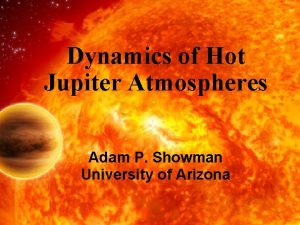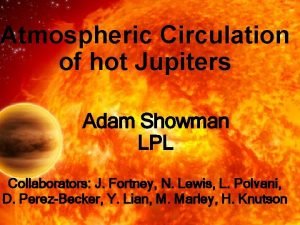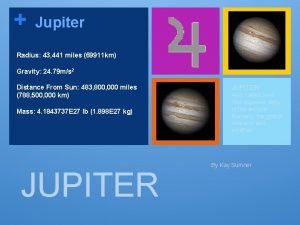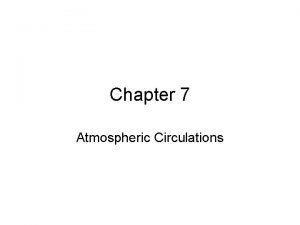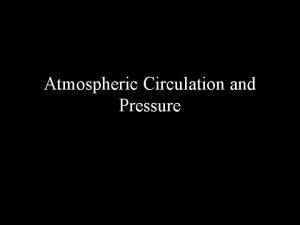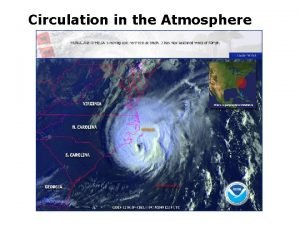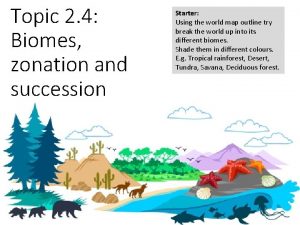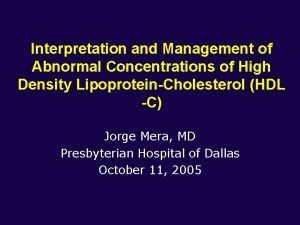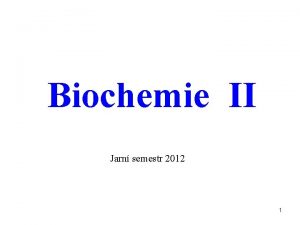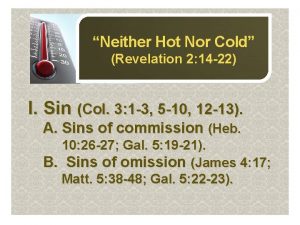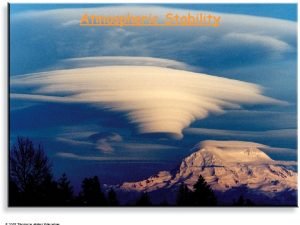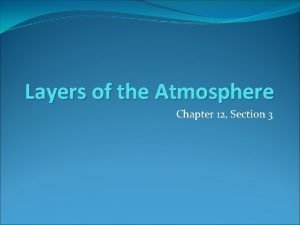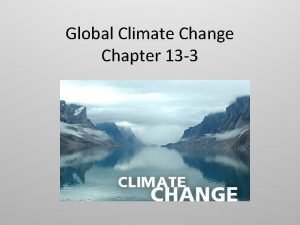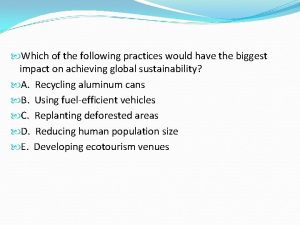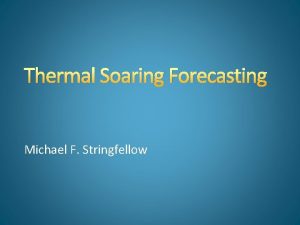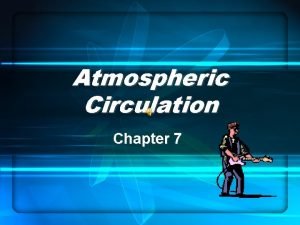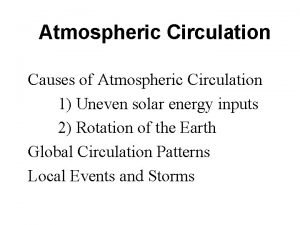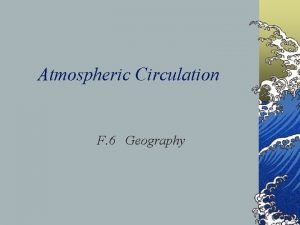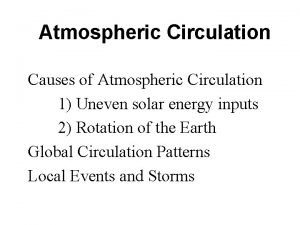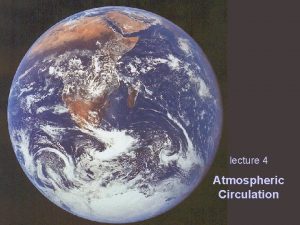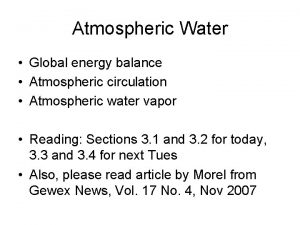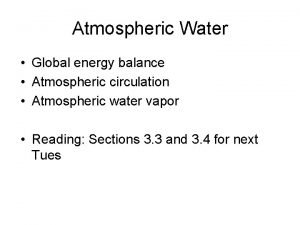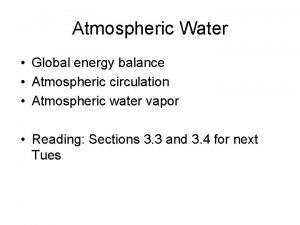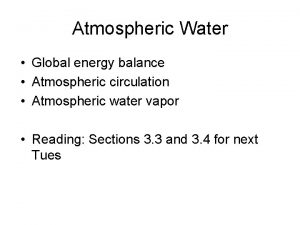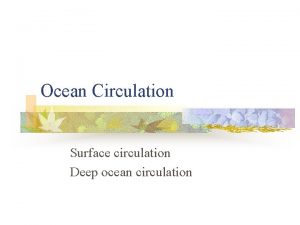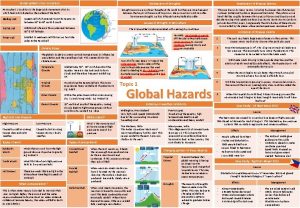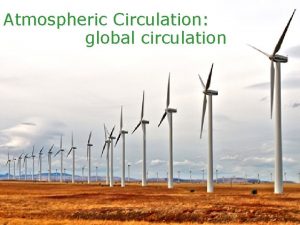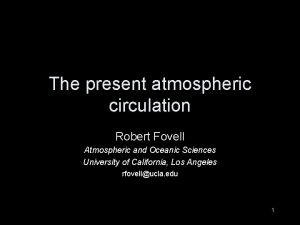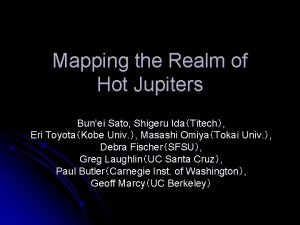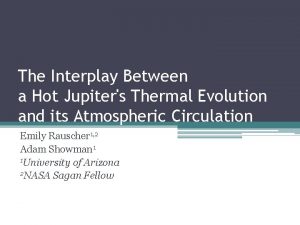Atmospheric Circulation of hot Jupiters Adam Showman LPL


























- Slides: 26

Atmospheric Circulation of hot Jupiters Adam Showman LPL Collaborators: J. Fortney, N. Lewis, L. Polvani, D. Perez-Becker, Y. Lian, M. Marley, H. Knutson

Spitzer light curves for HD 189733 b Knutson et al. (2007, 2009) 8 mm 24 mm

Dependence of day-night flux contrast on effective temperature

Motivating questions • What are the fundamental dynamics of this novel, highly irradiated circulation regime? Can we explain lightcurves of specific hot Jupiters? What is the mechanism for displacing the hottest regions on HD 189733 b? • What are mechanisms for controlling the day-night temperature contrast on hot Jupiters? Can we explain the increasing trend of day-night flux contrast with incident stellar flux? • What are predictions for direct wind detection via Doppler? Can we explain the Doppler measurements of HD 209458 b?

Dynamical regime of hot Jupiters • Circulation driven by global-scale heating contrast: ~105 W/m 2 of stellar heating on dayside and IR cooling on nightside • Rotation expected to be synchronous with the 1 -10 day orbital periods; Coriolis forces important but not dominant • Weather occurs in a statically stable radiative zone extending to ~100 -1000 bar

Hot Jupiter circulation models typically predict several broad, fast jets including equatorial superrotation Showman et al. (2009) Heng et al. (2010) Rauscher & Menou (2010) Dobbs-Dixon & Lin (2008)

Showman & Guillot (2002) Knutson et al. (2007)

Showman & Polvani (2 011, Ap. J 738, 71) Showman & Polvani (2011) showed that these jets result from momentum transport by standing, planetary-scale waves driven by the day-night thermal forcing

“Gill” pattern is clearly evident in spin-up phase of 3 D hot Jupiter simulations Showman & Polvani (2011)

Waves play a key role in adjusting thermal structure

Our dynamical theory predicts two regimes 1. At weak-to-moderate stellar fluxes and friction, planetary (Rossby and Kelvin) waves induce zonal jets and adjust thermal structure, leading to small day-night temperature differences. 2. Extreme stellar fluxes and/or friction damp the planetary waves, inhibiting zonal jet formation and leading to a large day-night temperature difference. Transition between regimes should occur when damping timescales are comparable to wave propagation time across a hemisphere: Kelvin wave propagation speed Propagation time across hemisphere Let’s now test this theory….

Weak damping Moderate damping Strong damping

The model explains the emerging observational trend Perez-Becker & Showman (in prep)

Perez-Becker & Showman (in prep)

Temperatures Homogenized Temps in rad. equilib Perez-Becker & Showman (in prep)

Timescale comparisons? • Several authors have suggested that a comparison betweent trad and tadvect determine whether the temperature difference is large or small • Our models show instead that twave is always the more relevant dynamical timescale

Conclusions Hot Jupiters occupy a dynamically unique regime of atmospheric circulation that does not exist in our Solar System. The intense daynight radiative forcing produces wind speeds >1 km/sec and temperature contrasts of ~200 -1000 K. The winds can distort the temperature pattern in a complex manner, with important implications for lightcurves and spectra. The radiative forcing generates equatorial superrotation that can displace the hottest regions to the east of the substellar point, explaining the observed offset on HD 189733 b. The superrotation results from upgradient momentum transport due to standing Rossby and Kelvin waves triggered by the longitudinal (day-night) heating variations. Our theory predicts a regime transition: Modest irradiation/friction allows the waves to adjust thermal structure and leads to small day-night temperature differences, but strong irradiation/friction damps the waves and leads to large day-night temperature differences. This explains the trend emerging in IR lightcurves and secondary eclipses. The same regime transition predicts a transition in wind pattern with implications for direct Doppler detection of atmospheric winds.


This dynamical theory predicts two regimes • At weak-to-moderate stellar fluxes and friction, standing planetary waves induce zonal jets. This causes bimodal blue and redshifted velocity peaks: • Extreme stellar fluxes and/or friction damp the planetary waves, inhibiting zonal jet formation and leading to predominant day-night flow at high altitude. This causes a predominant blueshifted velocity peak:

Dependence of flow regime on radiative and drag time constants 0. 06 0. 3 1. 4 6. 7 31 Zonal jet/eddy ratio

Lian & Showman (2010) Jupiter Saturn Uranus/Neptune

Similar wave damping processes can explain the trend of day-night temperature contrast versus incident stellar flux

Orbital distance Dependence of wind on rotation rate and orbital distance Rotation rate Lewis, Showman

Orbital distance Dependence of temperature on rotation rate and orbital distance Rotation rate Lewis, Showman

Simple models to isolate superrotation mechanism • To capture the mechanism in the simplest possible context, adopt the shallow -water equations for a single fluid layer: where g[heq-h] represents thermal forcing/damping, av represents drag, and where d=1 when Qh>0 and d=0 otherwise • First consider linear, steady analytic solutions and then consider full nonlinear solutions on a sphere.

Doppler detection of winds on HD 209458 b • Snellen et al. (2010, Nature) obtained high-resolution 2 mm spectra of HD 209458 b during transit with the VLT • Tentative detection of ~2 km/sec blueshift in CO lines during transit of HD 209458 b • Interpreted as winds flowing from day to night at high altitude (~0. 01 -0. 1 mbar)
 Adam showman
Adam showman Adam showman
Adam showman Radius of jupiter in km
Radius of jupiter in km Single cell model of atmospheric circulation
Single cell model of atmospheric circulation Circulates air between 60-90 latitudes
Circulates air between 60-90 latitudes Atmospheric circulation
Atmospheric circulation Prediction explanation
Prediction explanation Single vs double circulatory system
Single vs double circulatory system Single circulation and double circulation
Single circulation and double circulation Blood air barrier cells
Blood air barrier cells Tangier's disease
Tangier's disease Lpl biochemie
Lpl biochemie Wkt biochemia
Wkt biochemia Adam white facebook
Adam white facebook White hot vs red hot temperature
White hot vs red hot temperature Hot nor hot
Hot nor hot Cold working vs hot working
Cold working vs hot working Perbedaan hot lava dan hot lava volcano
Perbedaan hot lava dan hot lava volcano Air expands
Air expands The four main layers of the atmosphere
The four main layers of the atmosphere Atmospheric physics lecture notes
Atmospheric physics lecture notes Atmospheric suits
Atmospheric suits Global warming
Global warming Which of the following
Which of the following Dr jack soaring
Dr jack soaring Atmosphere
Atmosphere Air pressure at different altitudes
Air pressure at different altitudes
